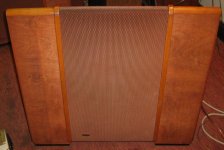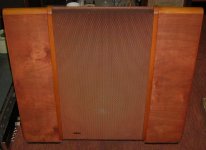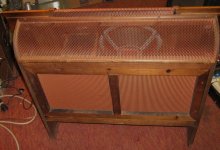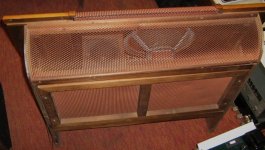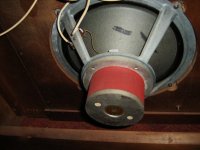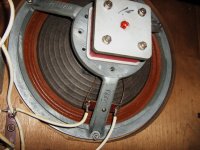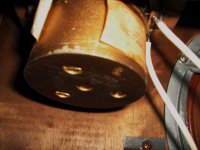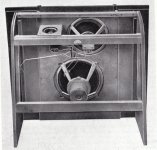devil - thanks for saying that - while something like the SFB design wouldn't suit my personal domestic constraints, it's not hard for me to imagine that a salient feature of its design is the upfiring tweeter.
I've built a couple of very modest designs with dual Mark Audio drivers in which one is top mounted. Compared to a variation on the same design with a more conventional bipole arrangement of the same drivers, the up-firing model delivers a much wider and deeper ambient sound soundstage, and has the advantage of greater placement flexibility.
Hi Chris. I experimented with a number of tweeter alternatives and placement variations just to see what would happen...the results quickly revealed that GB knew what he was doing with this design and had invested a lot of personal attention to getting it as right as possible.
What drew me to this design and other Wharfedale's of this genus was the fact GB was not afraid of putting them side by side with the ESL/57s and using Leak and other competitors amplification units to showcase his design. In fact, his series of pamphlets on High Fidelity routinely referenced the work of competitors...and never in a demeaning manner. That was and remains to this day pretty much unheard of.
I am not saying the SFB/3s are the finest or the best or the ultimate...but every bit--probably more--convincing than than contemporaneous ESL57s, Tannoys and Altecs and at a fraction of their going prices today.
Some pics of my SFB/3s for reference for those who might be interested...will post measurements as OP requested when I can.
Attachments
AmadeusMozart
I meant no disrespect of your opinions.
I recently built the Decca Corner Horn from 1955. Built in 9mm plywood with no damping material what so ever. The flexing of the walls (and they do flex quite a bit) was supposed to take care of the damping.
To my surprise it worked far better than I expected. However upon further investigation the result is due to smart folding and angling not flexing panels and adding some felt improved both sound and measurements. And yes with it backward firing driver it is hard to mesaure but it sounds good.
SFB was built to ship and be built to a decent cost. As a DIY you can go overboard with various improvements. All loudspeakerbaffles are subjected to substantial sound pressures ( and Newtons second law) and an open baffle does not get the natrual bracing a baffle in a box gets so it is extra critical in this regard.
I meant no disrespect of your opinions.
I recently built the Decca Corner Horn from 1955. Built in 9mm plywood with no damping material what so ever. The flexing of the walls (and they do flex quite a bit) was supposed to take care of the damping.
To my surprise it worked far better than I expected. However upon further investigation the result is due to smart folding and angling not flexing panels and adding some felt improved both sound and measurements. And yes with it backward firing driver it is hard to mesaure but it sounds good.
SFB was built to ship and be built to a decent cost. As a DIY you can go overboard with various improvements. All loudspeakerbaffles are subjected to substantial sound pressures ( and Newtons second law) and an open baffle does not get the natrual bracing a baffle in a box gets so it is extra critical in this regard.
AmadeusMozart
I meant no disrespect of your opinions.
I recently built the Decca Corner Horn from 1955. Built in 9mm plywood with no damping material what so ever. The flexing of the walls (and they do flex quite a bit) was supposed to take care of the damping.
To my surprise it worked far better than I expected. However upon further investigation the result is due to smart folding and angling not flexing panels and adding some felt improved both sound and measurements. And yes with it backward firing driver it is hard to mesaure but it sounds good.
SFB was built to ship and be built to a decent cost. As a DIY you can go overboard with various improvements. All loudspeakerbaffles are subjected to substantial sound pressures ( and Newtons second law) and an open baffle does not get the natrual bracing a baffle in a box gets so it is extra critical in this regard.
I never had the impression that you showed disrespect so all is well. It is unfortunate that a certain number of people that we meet on the internet have opinions about items they have never listened to and takes what is modelled on a computer as the "holy grail". Hence me asking if you ever listened to one and now reading back my posting I can see how this can be interpreted in another way than meant. My apologies.
I like to hear an open baffle with a small tube amplifier. Most of the "modern designs" rely on bi-amplification, elaborate crossovers etc.
The focus today appears to be more on a flat frequency response than anything else. Our ears are very attuned to phase anomalies, more so than to the SPL differences - phase is by which we determine direction. All the elaborate crossovers have an impact on phase.
As such the "modern, high and narrow" open baffle systems are out and I have to revert to something like the SFB/3. The Supravox drivers as used in the Panneau OB appeal to me and hopefully someone more clever than me can one day work out the optimum inductance that the 285 GMF is connecting with. Otherwise, if I get round to building it (bad health), I will need to determine this empirically.
Can't see how an SFB3 was built to ship,weighing in at 65 lbs its build doesn't appear compromised.
Modelling and simulating is one thing - we all know things that simulated well yet did not work properly after being build. If simulation would be the end-all, be-all then we would have no need for testifying planes, test driving cars etc. I don't think so.
On the contrary, all major aircraft are designed via computer simulations, FEA, CFD, CAD/CAM now, the test flight is requisite of certification process but companies like Boeing and Airbus invest $Billions into the tooling and production of the first production model - which was "flown" on a simulator before ever taking flight. Without good models that they can trust it would be financial disaster to spend that much capital on tooling for a 777 "sight or flight unseen".
Speaker simulation software is also now very good and I have designed and built speakers with very complex flow geometries where the measurements match almost to the "T" - every little dip and peak, location and shape of bass roll off knee, etc were all there. I was actually surprised myself how well the sims work now too. There are limits of course but if full blown 3d sims are used, you can almost guarantee that it will be spot on. The physics of CFD modeling of aircraft and speakers are not too far apart. All fluid mechanics.
Having said that, what designers were able to achieve 50 to 60 years ago with paper and pencil is still very impressive and no doubt some designs endure the test of time very well.
The ting with narrow (modern) vs wide (old fashioned) baffles have interested me a while. A ordinary loudspeaker will change from spherical to half spherical at some frequency determined by the baffle dimentions. The current fashion with very narrow baffles have moved this baffle step frequeny up at least a octave from the say 1960-1980. Then many high end speakers had a 12" and a wide baffle to match. Now they commonly have a couple of 6.5" crammed into a baffle as slim as possible. And the transition is in the 200-500 Hz range were music has the highest energy content. Two speakers with the same 1 m response but one 400 and one 200mm wide will energize the room differently in this critical octave.
The model building is fantastic for building according to what we currently know and can model and measure. Frequency response THD and IMD have been possible to measure for many years. Time domain a shorter time,. Klippel and others have more extensive tools, studies into Cepstral is interesting. But to really build higher fidelity we need to understand the function of the brain better, our hearing. And then get the parameters that are relevant to our perception of sound into the development as opposed to how a wave looks in an ocilloscope.
The model building is fantastic for building according to what we currently know and can model and measure. Frequency response THD and IMD have been possible to measure for many years. Time domain a shorter time,. Klippel and others have more extensive tools, studies into Cepstral is interesting. But to really build higher fidelity we need to understand the function of the brain better, our hearing. And then get the parameters that are relevant to our perception of sound into the development as opposed to how a wave looks in an ocilloscope.
Speaker simulation software is also now very good and I have designed and built speakers with very complex flow geometries where the measurements match almost to the "T" - every little dip and peak, location and shape of bass roll off knee, etc were all there. I was actually surprised myself how well the sims work now too.
Having dedicated the last 14 years of my life (full time and that means 12 to 14 hours /day, more often than not 7 days a week) to simulation programs I can categorically state that your reasoning and insights are flawed. There are a number of variables, even in something "as simple as in loudspeaker modelling", that are always missing. But I will not get drawn into that discussion. Simulation is not the same as the real world and hopefully one day you'll realise this.
Last edited:
Some pics of my SFB/3s for reference for those who might be interested...will post measurements as OP requested when I can.
can you post measurements like freq response ? 🙂
also interesting is nearfield response of each individual driver.
that would be extremely valuable !!!
.
What is flawed in my reasoning if I say that the simulation predicted the measurement accurately? Let's not get off topic here and end it now.
can you post measurements like freq response ? 🙂
also interesting is nearfield response of each individual driver.
that would be extremely valuable !!!
.
As I stated previously these are out on loan to a very close friend and I don't have regular access to them. As a member of the working proletariat I have so many day to day concerns ekeing out a minimum existence that I don't currently have access to the measuring tools required.
I'm not certain I would get to the measurement of these speakers any time soon...and I'm not at all certain that the physical environment these speakers are in would provide the objective data required.
I will attempt such measurement at some point...just can't say when.
I will say that I am continually reminded of the Nakamachi experience when modelling and measuring their TOTL reference line of loudspeakers in the 80s and finding them wanting in real world listening environments when compared to KEF/IMF models of the day.
There is an intuitive synergy to the SFB/3s that works beyond what modeling, measurement and technological advancement would suggest is possible.
I heard superperlatives about the SFB/3 in the late 70s from Mr. Paul Voigt of Voigt Corner Horn fame in the late 70s when by pure happenstance I ran into him at a consumer audio fair held in Toronto. He respected GB immensely despite GB's lack of an engineering background and mentioned that the SFB/3 was by far one of the best mass-produced Wharfedale products ever made. His opinion was that GB had answered the challenge posed by the introduction of the ESL by Quad and bested it in terms of overall performance. As we now know Voigt spent the latter years of his life fairly disillusioned with his experience and treatment in Britain during the war and forced to eke out a living working here in Canada.
I have never heard the Voigt corner horns but based on some recent rebuilds of his design I take his commendation of the SFB/3 design and GBs intuitive and tireless experimental approach with great respect. I wish I had known more about the man and his background in those days.
That stuck with me when I came across my first set of SFB/3s and needless to say I was not disappointed by what I heard. GBs insistence that they be measured in real world settings against live orchestras and utilizing competitors products gave me the confidence to acquire them over the years.
Sorry for meandering....😱
Last edited:
nicely said, but if I might offer a correction - no "h" in Voigt
Thanks Chris...that's the least I should do to respect PVs memory.
not sfb
My W70s came from Radio People in Singapore, and they have the flat green felt surrounds not the corrugated type visible in your photos. I'd never ask them for low bass.
My W70s came from Radio People in Singapore, and they have the flat green felt surrounds not the corrugated type visible in your photos. I'd never ask them for low bass.
I am assuming you have this photo of the SFB/3 already Marinus, but if not it will come in very handy as I will reference my measurements to it.
Regards. Leon
Yes, had found it already. Thank you, it always helps to know one is referencing to the same item (picture).
Retro Vintage SFB?
I have early W60s and W90s, and enjoy them very much. In addition, I have some loose W12s, and super 3s (all alnico). Finally, I've just been able to buy some early EMI DW13/3RS (12" woofers). 🙂
Apparently Dennis Ward of EMI went to B&W in 1969, bringing the design with him, and they (or a variant) wound up in the B&W DM70 electrostatics, as LF drivers, crossed over about 400-500 hz. Pics to follow when I take delivery.
Anyway, these apparently were designed for a very large (infinite baffle) cabinet approximately 32" x 19" x 15", all for LF up to 400 hz (only)! The balance was handled by the electrostatic panel.
So, anyway, instead of a great big box, I'm very interested in a poor man's SBF, with some combination of these. I appreciate that my W12s and Super 3's aren't Gilbert Briggs's special units, but I'd very much like to see what I can get out of this mix.
So, here's the question, I'm pretty sure that I've got LF covered, and with the W12 as mid-woofer, I'm probably OK to about 1600, but I fear a (BIG) gap from there to 5000 where the tweet crossover sits. Does anyone know what the choke (inductor) for the W12 in the W60 and W90 value is? I don't know how high up I can expect to run it.
Any thoughts?
I have early W60s and W90s, and enjoy them very much. In addition, I have some loose W12s, and super 3s (all alnico). Finally, I've just been able to buy some early EMI DW13/3RS (12" woofers). 🙂
Apparently Dennis Ward of EMI went to B&W in 1969, bringing the design with him, and they (or a variant) wound up in the B&W DM70 electrostatics, as LF drivers, crossed over about 400-500 hz. Pics to follow when I take delivery.
Anyway, these apparently were designed for a very large (infinite baffle) cabinet approximately 32" x 19" x 15", all for LF up to 400 hz (only)! The balance was handled by the electrostatic panel.
So, anyway, instead of a great big box, I'm very interested in a poor man's SBF, with some combination of these. I appreciate that my W12s and Super 3's aren't Gilbert Briggs's special units, but I'd very much like to see what I can get out of this mix.
So, here's the question, I'm pretty sure that I've got LF covered, and with the W12 as mid-woofer, I'm probably OK to about 1600, but I fear a (BIG) gap from there to 5000 where the tweet crossover sits. Does anyone know what the choke (inductor) for the W12 in the W60 and W90 value is? I don't know how high up I can expect to run it.

Any thoughts?
wharfedale sfb3
Hello,
Would you be willing to sell a pair of the Wharfedale sfb3's ? If not may i ask where you located them? I'm currently scrowering the net to try and find a pair with no luck..PLease let me know..thank you!...Andy
I have worked on three sets of the SFB/3s in the past decade with one pair remaining and currently on loan to a close friend...who's been unwilling to return them despite already owning a set of Tannoy Monitor Gold 12s and a set of the ESL57s.
I will try and get you measurements as soon as I can.
You are aware that the two main drivers 12" and 10" drivers for the SFB3s were specific to this unit and employed longer throw voice coils? I've had a chance to measure them against what some misguided souls have tried to substitute other Wharfedale 12" and 10" drivers for defective SFB/3 units.
Additionally Briggs' use of a SFB baffle contributes, in no small measure, to their superb performance.
Alas, GB, often seemed to get distracted with new, and mostly inferior, designs and the SFB3 design was relegated to relative obscurity while clearly inferior products such as the W60/70/90 and others marked the d-evolution of subsequent Wharfedale offerings.
The ESL57 was, is, a remarkable loudspeaker particularly its airy HF and MF reproduction, but it had/has a few significant weaknesses...weak LF response, narrow sound-stage and the need for its own on-board power supply.
The beauty of the SFB/3 was, and is, it's x/over simplicity, high sensitivity, wide sound-stage, and excellent LF response and it comes within a breath of rivaling the ESL57s in HF and MF response and for my money a better overall loudspeaker for a wider range of music.
Hello,
Would you be willing to sell a pair of the Wharfedale sfb3's ? If not may i ask where you located them? I'm currently scrowering the net to try and find a pair with no luck..PLease let me know..thank you!...Andy
- Status
- Not open for further replies.
- Home
- Loudspeakers
- Full Range
- Wharfedale SFB sizes anyone?
